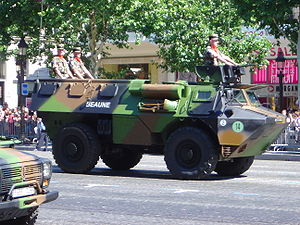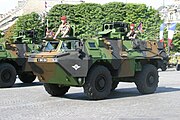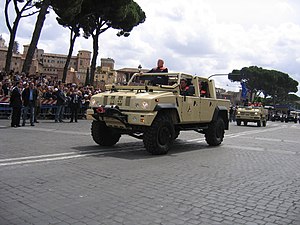The Ski Section - Specialist EquipmentTroops normally use skis normally in cross country skiing but also by pulling squads of soldiers with tracked transport vehicles. Two ropes hang from the end of a vehicle and troops hold the rope with their hands. This is especially difficult if one is carrying the normal heavy-backpack.

---------------------------------------
Mountain Warfare Specialist EquipmentMountain warfare is one of the most dangerous, as it involves fighting not only the enemy but also the extreme cold and inaccessible heights. The problems multiply due to avalanches of snow or rocks, either natural or induced by the enemy.
The long nights and great distances on huge, snow-covered peaks at sub-zero degree temperatures demands much endurance and patience. Winning the warfare essentially boils down to holding the high ground in the battle. Attacking an enemy position entrenched in a mountain warfare scenario requires a greater ratio of attacking soldiers to defending soldiers, than would be needed on the plains (It is generally accepted that the ratio required for the force launching an offensive to have a good chance of success is 3:1. In mountainous terrain, the required ratio is much more). Mountains, at any time of year, are dangerous -- lightning, high wind, rock fall, extreme cold, or falls into crevasses and cliffs all being able to cause death. In war, the dangers multiply exponentially. Movement, medical evacuation and reinforcements up steep slopes, often where even mules cannot go, involves an enormous exertion of energy.
---------------------------------------
Arctic Warfare Specialist EquipmentArctic warfare is very dependent on equipment. For survival, troops need warm clothing and footwear, extra nutritious food, white camouflage, tents with sleeping bags, heaters and fuel.
Mobility can be increased by skis and snowshoes. Many vehicles are unfit to stand freezing temperatures, and need to be specially constructed. Studded tires are useful for wheeled vehicles.

---------------------------------------
General Hardware for Ski, Mountain and Arctic WarfareVehicle List:1. Bandvagn 206
Bandvagn 206 (Bv 206) is a tracked articulated, all-terrain carrier. It consists of two units, with all four tracks powered. It can carry up to 17 people (6 in the front compartment, 11 in the rear), although the trailer unit can be adapted for different applications (see Variants section).

The Bv 206 is designed to carry troops and equipment through snow and bog-lands in northern Templarios. The low ground pressure enables the Bv 206 to cope with a wide range of difficult conditions. It is also fully amphibious, with a speed in water of up to 4.7 km/h. The total load capacity is 2,250 kg and a trailer of up to 2,500 kg gross weight can also be towed behind the second compartment.

This tracked vehicle, a Hägglunds Bv206, achieves low ground pressure through full-length, wide rubber tracks and a lightweight body. The two sections of the vehicle are articulated, allowing it to keep contact with the ground over broken terrain. The ground pressure is low enough that the vehicle can traverse loose snow without sinking. The fiberglass body is even amphibious, and the vehicle is propelled in water by its tracks.
 VariantsBv 206A
VariantsBv 206A - $4500
The Bv206A is an ambulance version, which is capable of carrying stretchers in the rear compartment.
Bv 206F - $4000
The BV206F is a fire appliance variant.
PvBv 2062 - $5500
The PvBv 2062 is an open top version of the Bv 206 armed with a 90 mm Pvpj 1110 recoilless anti-tank gun (the Pansarvärnspjäs 1110 (Pvpj 1100) is a 90 mm rifled recoilless rifle - see below for more details).
PvBv 2063 - $6000
The PvBv 2063 is similar to PvBv 2062 but fitted with the launch system for an ATGM (Anti-tank guided missile - see below for details), either the TOW (Rbs 55)( Anti-tank 'Tube launched, Optically tracked, Wire command link guided' - see below for details) or the Bofors BILL (Rbs 56) (Anti-tank guided weapon - see below for details).
Bv 206S - $5000
The Bv206S is an armoured personnel carrier variant of the Bv 206, which provides protection from small arms fire for the occupants.
The vehicle can carry the driver and 11 combat equipped troops — four in the front compartment and eight in the rear. The Bv 206S can be under slung and air lifted by Boeing CH-47 Chinook and Sikorsky CH-53E Super Stallion helicopters or carried in the C130 Hercules airplane, amongst others.
Other variants
Numerous other variants exist including cargo carrier, fuel carrier, radar, command post and radio relay. The units can easily be customised to meet the specific needs of a customer.
Please quote the number of each different variant with their variant number. If requesting other variant - please ask for a quote.
Specifications: * Engine: 2.8L 99 kW Ford Cologne V6, in Norway Cummins 6CTA8 diesel engine with 260 hp
* Gearbox: MB W 4A-018 automatic transmission
* Weight: 4500 kg
* Cargo load: 2240 kg (630 kg in front unit and 1610 kg in trailer unit)
* Length: 6.9 m
* Width: 1.87 m
* Height: 2.4 m
2. BVS10The BVS10 - is an All Terrain Armoured Vehicle.
The BVS10, not to be confused with the BV206 or BV206S, is a much larger and fully amphibious armoured vehicle based upon the characteristic twin-cab, articulated steering system typical of Hagglunds all terrain vehicles.
Variants:- The Troop Carrying Variant (TCV) capable of carrying 2 crew plus 10 passengers
- $8000
- Command Variant (CV), which carries 2 crew plus up to 8 passengers with the rear cab being designed as an enhanced digital communications platform
- $12,000
- The Repair and Recovery Variant (RRV), carrying 4 specialist maintenance (Vehicle Mechanic) crewmen. The rear cab of the RRV carries a HIAB crane, a full mobile workshop, an air compressor and a 9 tonne capacity CAPSTAN winch, together with hydraulic anchors
- $16,500
[/list]
All three variants are fully air-portable under a CH-47 Chinook helicopter (either complete or in two separate front and rear component parts) and are also fully amphibious; being capable of swimming in varying sea-states with a full load of passengers and stores.
The main differences with the older Bv206s is a more powerful Cummins 5.9L diesel engine, improved ground clearance and newly developed chassis, power train and steering units that give the vehicle considerably enhanced speed and comfort on road and in terrain, as well as greater load carrying capability (up to 5 tons), and the ability to add various modular sub-systems such as add-on armour, weapon-mounts, a load-changer and cargo platforms.
3. Bronco All-Terrain Tracked Carrier - $15,000
The Bronco all-terrain tracked carrier (ATTC) is one of 2 armoured ATTCs in the world. The other is the carrier above. The Bronco has a higher payload at 5 tons and longer range than the S10.
The company is also manufacturing the firefighter and other civilian variants of the ATTC, where it is positioned as a disaster recovery vehicle with its ability to access uneven and soft terrains impassable to normal vehicles after earthquakes, floods or other major urban catastrophes.
4. VAB ("Armoured Vanguard Vehicle")The Véhicule de l'Avant Blindé or VAB ("Armoured Vanguard Vehicle") is an armoured personnel carrier and they are amphibious (propelled in the water by two water jets mounted one either side of hull rear), NBC-proof, have excellent off-road capabilities, and can be configured in numerous versions.

Specifications
Weight 13 tonnes
Length 5.98 m
Width 2.49 m
Height 2.06 m
Crew 2
Primary
armament 1 × 12.7 mm machine gun
Secondary
armament -
Engine Renault MIDR 062045
300 hp (224 kW)
Power/weight 23 hp/t
Payload capacity 10 troops
Suspension wheeled
Operational
range 1,000 km
Speed 92 km/h
Variants may be 4x4 or 6x6 wheels. The French military mainly uses 4-wheel versions, with the Engineers Corp (Génie) having 6-wheels versions with enhanced amphibious capabilities. Export versions are also 6x6's.
* VAB P (transport of 12 fully equipped troops)
* VAB T-20/13 (VAB equipped with a turret mounted 20 mm gun recovered from old AMX-13 VCIs and refurbished and intended for fire support and for counter sniping) - see picture below

* VAB-VOA (artillery observation vehicle)
* VAB-RATAC (Radar Artillery target acquisition vehicle)
* VAB-PC (command vehicle)
* VAB-SIR (digital regimental C4ISTAR Information system)
* VAB Hot(HOT anti-tank missile vehicle, HOT with a range of 4000m) - see picture below

* VAB Portee - mortar carrier with an 81 mortar or for towing a 120 mm mortar
* VAB SAN (armoured ambulance)
* VAB NBC (NBC reconnaissance vehicle)
* VAB ATLAS (artillery fire command and control vehicle)
* VAB AZURE (urban warfare vehicle) equipped with a dozer blade and with panoramic periscopes to observe and monitor.
* VBC-90 - armoured car variant equipped with a 90 mm high velocity gun in a GIAT TS 90 rotating turret
Detail of propeller for amphibious operation below:

5. Iveco VTLM Lince 4WD tactical vehicles
Design
The LMV uses modular armor packs to adjust its level of protection to its mission requirements. As regards mine protection the vehicle height on the ground has been increased to 493 mm without augmenting the overall height (less than 2 metre); it uses also suspended seats of aereonautical derivation, v-hull under body, and a collapsible sandwich structure in the floor to deflect and absorb mine blasts. Its exhaust is piped through its C-Pillars, and its turbocharger is located underneath the engine to reduce its thermal signature. Mobility is helped by a run-flat system, allowing the vehicle to move even whith completely deflated tyres.
Variants* Panther CLV
The Panther Command and Liaison Vehicle or Panther CLV is another variant of the Iveco LMV. The Panther CLV came from the "Future Command and Liaison Vehicle" (FCLV) project. The Panther seats 4, while the VTLM Lince seats 5.
Other Variants
* The LMV is available in two different wheelbases, 3.2 and 3.5 meters.
* A two door, two seater is also available.
 Specifications
SpecificationsWeight 6,5 tons (STANAG 4569 Level 3)[1]
Length 5504 mm (4704 mm)
Width 2050 mm
Height 1950 mm
Crew 1+4[2]
1+3 (Panther)
1+6 (Stretched Variant)
Armor STANAG 4569 Level 1-4[3]
Primary
armament Remote Weapon System
Engine IVECO F1D Common Rail EURO 3
136 kW (185 Hp)
Payload capacity 1200kg
Transmission 6 speed automatic[4]
Suspension Independent, Double A-Arm
Ground clearance 473mm
Operational
range 500+ km
Speed >130 km/h
6. Puma (AFV) 
The Puma light wheeled armoured fighting vehicle family consists of the Puma 6x6 and the Puma 4x4.
The 4X4 variant carries two soldiers in addition to the driver and gunner, and is used in pairs for battlefield reconnaissance. The 6X6 version carries four soldiers plus driver and gunner, and together with another Puma 6X6 can carry an entire Templarion infantry squad of eight men.

Personal Weaponry:- FAMAS
- FN MINIMI
- FR F2 sniper rifle
- PGM Hecate II Heavy Sniper Rifle
- LGI light mortar
- Beretta SC70/90 assault rifle
- Beretta 92 FS pistol
- OD/82SE hand grenades
- Type III AP/98 bullet-proof vest
- 3rd generation night vision device
Anti-Tanks Weapons:- AT4 anti-tank missile
- ERYX anti-tank missile
- MILAN anti-tank missile
- 90 mm Pvpj 1110 recoilless anti-tank gun
- ATGM (Anti-tank guided missile)
- TOW (Rbs 55)( Anti-tank 'Tube launched, Optically tracked, Wire command link guided')
- Bofors BILL (Rbs 56) (Anti-tank guided weapon)
Mortars:- LLR 81 mm mortar
- the MO-120-RT-61 120 mm heavy mortar
Machine Guns and Cannons:- M2 machine gun
- vehicle-mounted 20 mm autocannon
- the Rheinmetall MG3 (sometime still called MG42)
- FN Minimi
- M2 Browning (0.50") machine gun
- the Hirtenberger M6C-210 Commando 60 mm
Artillery:
This lightweight gun (1273 kg) can be manhandled by its crew, allowing its use in direct fire support role. Furthermore, it can be easily disassembled in 12 separate loads for ease of transportation, allowing its deployment almost anywhere in the rugged terrain of a mountain battlefield.
SpecificationsWeight 1 273 kg (2 806 lb)
Length 14 calibre: 1.47 m (57.9 in)
Caliber 105 mm
Elevation -7° to +65°
Traverse 56°
Muzzle velocity 416 m/s (1 345 ft/s)
Maximum range 11 100 m (12 140 yd)
The Mod 56 has a number of unique characteristics for a weapon of its caliber, including the ability for its crew to manhandle the gun (due to its light weight, and the capability of being able to be used in the direct fire role. Being a pack howitzer it is designed to be broken down into 12 parts, each of which can be easily transported.[1] The capability of this weapon to be "knocked-down" allows the sections to be easily transported a number of ways, including by mule. This has made the gun rather popular with Mountain and Airborne troops.

FH 70 had several interesting features including:
* a vertical sliding block breech that provided obturation and held a primer magazine containing 12 primers
* burst fire
* an on-board 1700 cc Volkswagen engine to power hydraulics to assist bring the gun in and out of action (with hand pump back-up) and to move the gun up to 20 km at low speed without towing by an artillery tractor
* electronic firing data display taking data from the otherwise conventional azimuth and elevation sights.
The barrel was 39 calibres long giving 827 m/s standard maximum MV. It had a muzzle brake giving 32% efficiency.
Other conventional features included a split trail and turntable sole plate. Initially it had assisted loading but became an early user of flick-ramming. In accordance with long-standing Templarion practice it used one-man laying. All this meant the gun could be operated by a minimum detachment of only 4 men (commander, layer and 2 loaders). The burst fire rate was 3 rounds in 15 seconds. It was also fitted with a direct fire telescope.
SpecificationsWeight 7,800-9,600 kg
Barrel length 39
Crew 8
Caliber 155 mm
Carriage Split trail, sole plate, auxiliary power unit and hydraulics
Elevation -100 to +1250 mils
Traverse 500 mils left and right
Rate of fire burst 3 rounds in 15 seconds, 3-6 rounds per minute
Muzzle velocity 827 m/s
Effective range 24-30 km (depending on ammo)
Other Equipment:http://en.wikipedia.org/wiki/C4ISTARTo Finish...
Last Updated: 02/01/08